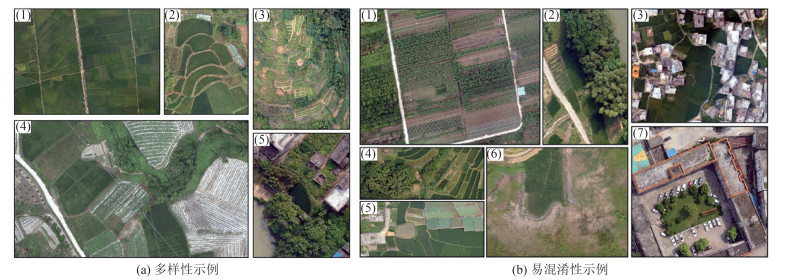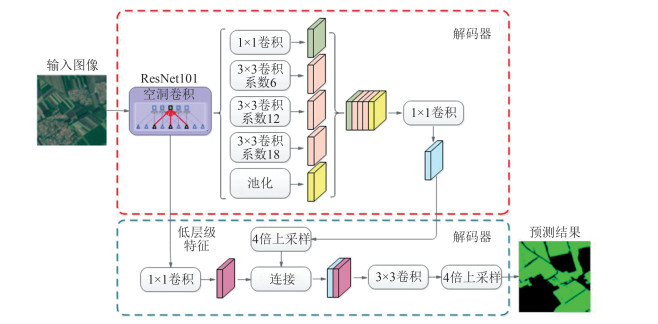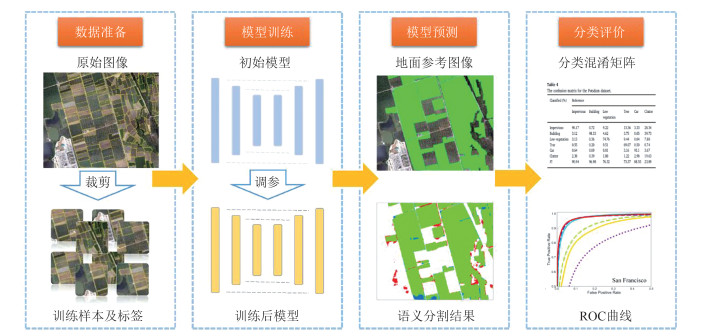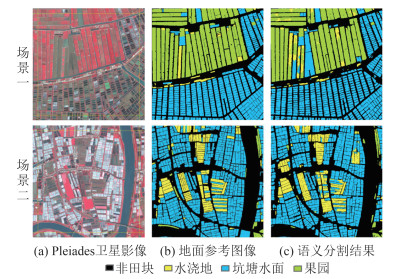Progress and Prospect of Cultivated Land Extraction from High-Resolution Remote Sensing Images
-
摘要:
耕地资源的快速、精准提取是支撑耕地保护和耕地用途管制的重要基础。随着高分辨率遥感和人工智能技术的快速发展,高分辨率遥感耕地提取已逐渐由传统的基于像元和面向对象的分类算法过渡至以深度学习为代表的智能化耕地提取新阶段,并取得不少成果,但也同样面临着诸多挑战。首先,梳理和分析了传统耕地提取算法和基于深度学习的智能化耕地提取算法的研究现状,阐述了深度学习支持下的耕地提取研究的必要性;然后,结合全卷积神经网络的发展历程,介绍了深度语义分割技术的基本原理以及在耕地提取应用中的实验流程,并归纳了主要的智能耕地提取算法;最后,围绕智能化耕地提取研究存在的不足,探讨了智能化耕地提取技术的发展趋势。
Abstract:The rapid and accurate extraction of cultivated land is essential for supporting the protection of cultivated land and controlling cultivated land use. With the rapid development of high-resolution remote sensing and artificial intelligence technology, high-resolution cultivated land extraction has gradually transitioned from traditional pixel-based and object-oriented classification algorithms to intelligent cultivated land extraction represented by deep learning. Although many achievements have been made, the new technologies still face significant challenges. First, we sort out and analyze the research status of cultivated land extraction based on traditional machine-learning approaches and deep-learning techniques, which expounds on the necessity in cultivated land extraction. Second, we introduce the basic principle of deep semantic segmentation technology and the experimental process of cultivated land extraction, and summarize the state-of-the-art intelligent cultivated land extraction algorithms. Finally, focusing on some shortcomings of intelligent cultivated land extraction, the development trend of intelligent cultivated land extraction is discussed.
-
数据融合最初仅仅局限于军事领域,是针对异质传感器产生的海量数据进行一致性估计的方法[1-3]。20世纪90年代后,数据融合的概念被引入中国[4]。文献[5]将数据融合的结构分为3层,即数据层、特征层和决策层,在不同层进行数据融合会得到不同的结果,其差异体现在融合精度和处理效率等方面,此结构也作为基本的数据融合结构应用于其他领域。
在大地测量领域,文献[6]从函数模型误差和随机模型误差两方面详细讨论了不同的融合结果,具有较大的理论意义,相关的数据融合应用也较为广泛,体现在GPS与INS组合导航[7]、GPS与InSAR[8]、GPS不同系统间的融合[9]、遥感图像及地图数据融合[9, 10]以及3S集成[11]等方面。在工业测量中,相关的数据融合理论方法并不常见,文献[12]介绍了在盾构自动导向中综合利用全站仪和倾斜仪数据联合平差解算盾构姿态的方法,体现了采用多源异质传感器进行数据融合的优势。
在mm级精度的工业测量中,是采用全站仪进行特定点的三维坐标的采集,全站仪是测距仪(获取斜距)和经纬仪(获取角度)的集成,其获取的坐标实际是测距数据和测角数据的融合结果;而在船舶、飞机制造等工业测量领域,由于一些大型构件无法一站式获取全部待测点位三维信息,需采用移站测量(moving station method, MSM)的方法[13],通过在不同测站上重复测量公共点,将不同测站的坐标系统一起来。但是,随着移站次数的增加,测量误差会不断积累,影响整体测量的精度。
本文以工业测量整体平差(overall adjustment, OA)为例,讨论了两种不同数据融合方法,即基于原始观测值(水平角、竖直角、斜距)的平差模型和基于坐标观测值(直角坐标系中的三维坐标)的平差模型,从解算精度、多余观测值的敏感性以及随机模型偏差对结果的影响等3方面,详细对比了两者的区别并和传统的移站测量结果进行比较,得到在工业测量中融合策略选取的相关结论。
1 工业测量整体平差函数模型
1.1 基于原始观测值的模型
在传统的工业测量中,采用全站仪获取数据是使用最多的方法之一。在每站测量前经过整平后,全站仪的原始观测值为测站点到待测点的水平方向、竖直角和斜距,这3个观测值互相独立,并在全站仪出厂时会给出角度和距离测量的标称精度。通常所有的待测点无法在一个测站全部观测,故采用移站测量的方法将不同测站的坐标系通过重复测量公共点进行统一,一般都以起始测站的坐标系作为全局坐标系。
在基于原始观测值的整体平差函数模型中,设第j测站在全局坐标系中的坐标为$ \left( {{{\hat{X}}}_{\text{stat}-j}}, \ \ {{{\hat{Y}}}_{\text{stat}-j}}, \ \ {{{\hat{Z}}}_{\text{stat}-j}} \right) $,测量了n个全局坐标系中的待测点$ \left( {{{\hat{X}}}_{i}}, \ \ {{{\hat{Y}}}_{i}}, \ \ {{{\hat{Z}}}_{i}} \right) $,其中i=1, 2, …, n,则有:
$$ \left\{ \begin{array}{l} {L_{\rm{s}}} + {V_{\rm{s}}} = \sqrt {{{\left( {{{\hat X}_i} - {{\hat X}_{{\rm{stat}} - j}}} \right)}^2} + {{\left( {{{\hat Y}_i} - {{\hat Y}_{{\rm{stat}} - j}}} \right)}^2} + {{\left( {{{\hat Z}_i} - {{\hat Z}_{{\rm{stat}} - j}}} \right)}^2}} \\ {L_{\rm{H}}} + {V_{\rm{H}}} = \arctan \frac{{{{\hat Y}_i} - {{\hat Y}_{{\rm{stat}} - j}}}}{{{{\hat X}_i} - {{\hat X}_{{\rm{stat}} - j}}}} - {{\hat A}_{{\rm{azi}} - j}}\\ {L_{\rm{V}}} + {V_{\rm{V}}} = \arctan \frac{{{{\hat Z}_i} - {{\hat Z}_{{\rm{stat}} - j}}}}{{\sqrt {{{\left( {{{\hat X}_i} - {{\hat X}_{{\rm{stat}} - j}}} \right)}^2} + {{\left( {{{\hat Y}_i} - {{\hat Y}_{{\rm{stat}} - j}}} \right)}^2}} }} \end{array} \right. $$ (1) 式中,Ls、LH、LV分别为斜距、水平角、竖直角观测值;对应Vs、VH、VV为观测值的改正数;$ {{\hat{A}}_{\text{azi}-j}} $为第j测站在全局坐标系中水平角初始零方向参数。将式(1)线性化后有:
$$ \left\{ \begin{array}{l} {V_{\rm{s}}} = {p_1}\delta {{\hat X}_{{\rm{stat}} - j}} + {p_2}\delta {{\hat Y}_{{\rm{stat}} - j}} + {p_3}\delta {{\hat Z}_{{\rm{stat}} - j}} - {p_1}\delta {{\hat X}_i} + {p_2}\delta {{\hat Y}_i} + {p_3}\delta {{\hat Z}_i} - {l_s}\\ {V_H} = - {p_4}\delta {{\hat X}_{{\rm{stat}} - j}} + {p_5}\delta {{\hat Y}_{{\rm{stat}} - j}} + {p_4}\delta {{\hat X}_i} - {p_5}\delta {{\hat Y}_i} - \delta {{\hat A}_{{\rm{az}} - j}} - {l_H}\\ {V_V} = {p_6}\delta {{\hat X}_{{\rm{stat}} - j}} + {p_7}\delta {{\hat Y}_{{\rm{stat}} - j}} + {p_8}\delta {{\hat Z}_{{\rm{stat}} - j}} - {p_6}\delta {{\hat X}_i} + {p_7}\delta {{\hat Y}_i} + {p_8}\delta {{\hat Z}_i} - {l_V} \end{array} \right. $$ (2) $$ \left\{ \begin{array}{l} {p_1} = \frac{{{X_{{\rm{stat}} - {j_0}}} + {X_{{i_0}}}}}{{{S_{{i_0}}}}}\\ {p_2} = \frac{{{Y_{{\rm{stat}} - {j_0}}} + {Y_{{i_0}}}}}{{{S_{{i_0}}}}}\\ {p_3} = \frac{{{Z_{{\rm{stat}} - {j_0}}} + {Z_{{i_0}}}}}{{{S_{{i_0}}}}}\\ {p_4} = \frac{{{Y_{{\rm{stat}} - {j_0}}} + {Y_{{i_0}}}}}{{D_{{i_0}}^2}}\\ {p_5} = \frac{{{X_{{\rm{stat}} - {j_0}}} + {X_{{i_0}}}}}{{D_{{i_0}}^2}}\\ {p_6} = \frac{{\left( {{Z_{{\rm{stat}} - {j_0}}} - {Z_{{i_0}}}} \right) \cdot \left( {{X_{{\rm{stat}} - {j_0}}} - {X_{{i_0}}}} \right)}}{{{D_{{i_0}}} \cdot \left( {D_{{i_0}}^2 + {{\left( {{Z_{{\rm{stat}} - {j_0}}} - {Z_{{i_0}}}} \right)}^2}} \right)}}\\ {p_7} = = \frac{{\left( {{Z_{{\rm{stat}} - {j_0}}} - {Z_{{i_0}}}} \right) \cdot \left( {{Y_{{\rm{stat}} - {j_0}}} - {Y_{{i_0}}}} \right)}}{{{D_{{i_0}}} \cdot \left( {D_{{i_0}}^2 + {{\left( {{Z_{{\rm{stat}} - {j_0}}} - {Z_{{i_0}}}} \right)}^2}} \right)}}\\ {p_8} = \frac{{ - D_{{i_0}}^2}}{{{D_{{i_0}}} \cdot \left( {D_{{i_0}}^2 + {{\left( {{Z_{{\rm{stat}} - {j_0}}} - {Z_{{i_0}}}} \right)}^2}} \right)}}\\ {l_{\rm{s}}} = {L_{\rm{s}}} - {S_{{i_0}}};\\ {l_H} = {L_H} + {A_0} - {A_1}\\ {l_V} = {L_V} - \arctan \frac{{{Z_i} - {Z_{{\rm{stat}} - {j_0}}}}}{{{D_{{i_0}}}}} \end{array} \right. $$ (3) 式中,Xstat-j0、Ystat-j0、Zstat-j0为在全局坐标系中第j测站坐标的近似值;Xi0、Yi0、Zi0为在全局坐标系中第i目标点的坐标近似值;A0为初始零方向近似值;A1为通过测站和目标点近似值解算的初始零方向,两者的范围都为0°~360°;Si0和Di0分别为通过测站点和目标点近似值求得的点间距及其水平投影。由于式(1)为非线性函数,求解通过最小二乘法迭代,这些近似值在不断迭代的过程中经求解的改正数调整,直到求解的改正数小于某一给定的阈值δ。
在某次测量任务中,假设共测了s个测站,目标点一共有t个,以第一站的坐标系作为全局坐标系,则需要解得参数共有(s-1)×3+t×3+(s-1)个。需要注意的是,在t个目标点中某些点是可以在多个测站中重复观测的,也就是在移站测量中的公共点。参数解为:
$$ \begin{array}{*{20}{c}} {\mathit{\boldsymbol{\hat X}} = }\\ {\left( {\underbrace {\begin{array}{*{20}{c}} {\delta {{\hat X}_{{\rm{stat}} - 2}}}&{\delta {{\hat Y}_{{\rm{stat}} - 2}}}&{\delta {{\hat Z}_{{\rm{stat}} - 2}}}& \cdots &{\delta {{\hat X}_{{\rm{stat}} - s}}}&{\delta {{\hat Y}_{{\rm{stat}} - s}}}&{\delta {{\hat Z}_{{\rm{stat}} - s}}} \end{array}}_{s - 1个测站坐标}} \right.}\\ {\underbrace {\begin{array}{*{20}{c}} {\delta {{\hat X}_1}}&{\delta {{\hat Y}_1}}&{\delta {{\hat Z}_1}}& \cdots &{\delta {{\hat X}_t}}&{\delta {{\hat Y}_t}}&{\delta {{\hat Z}_t}} \end{array}}_{t\;个目标点坐标}}\\ {{{\left. {\underbrace {\begin{array}{*{20}{c}} {\delta {{\hat a}_{{\rm{azi}} - 2}}}& \cdots &{\delta {{\hat a}_{{\rm{azi}} - s}}} \end{array}}_{s - 1个测站初始零方向参数}} \right)}^{\rm{T}}}} \end{array} $$ (4) 由于第一个测站的测站坐标和初始零方向都为0,因此该测站列立的误差方程仅有目标点的坐标参数。
观测方程的随机模型由仪器标定精度给定,测距精度σs=(a+b×Ls), a为固定误差,b为比例误差, Ls为测站点到目标点的斜距;由于一般测量目标点的角度值都是半测回测一次的结果,而标称精度一般为一测回方向的精度,所以实际的测角精度σangle为给定测角精度的$ \sqrt{2} $倍,在空间上带来的误差影响为σangle×Ls。此外,距离观测与角度观测之间是独立的,因此基于原始观测值的整体平差权阵为对角阵。对于一次观测目标点的3个原始观测值权阵为:
$$ {\mathit{\boldsymbol{P}}_1} = {\rm{diag}}\left[ {\begin{array}{*{20}{c}} {\frac{{\sigma _0^2}}{{\sigma _s^2}}}&{\frac{{\sigma _0^2}}{{{{\left( {{\sigma _{{\rm{angle}}}} \times {L_s}} \right)}^2}}}}&{\frac{{\sigma _0^2}}{{{{\left( {{\sigma _{{\rm{angle}}}} \times {L_s}} \right)}^2}}}} \end{array}} \right] $$ (5) 式中,σ0为给定的验前单位权中误差,一般设定为1 mm。验后单位权中误差由式(6)求得:
$$ \hat \sigma _0^2 = \frac{{{\mathit{\boldsymbol{V}}^{\rm{T}}}{\mathit{\boldsymbol{P}}_1}\mathit{\boldsymbol{V}}}}{{n - \left( {s - 1} \right) \times 4 - t \times 3}} $$ (6) 式中,n为总的观测值个数; V为式(2)中的残差向量,则求解参数$ \mathit{\boldsymbol{\hat{X}}} $的精度:
$$ {\mathit{\boldsymbol{D}}_{\hat X\hat X}} = \hat \sigma _0^2{\mathit{\boldsymbol{Q}}_{\hat X\hat X}} = \hat \sigma _0^2{\left( {{\mathit{\boldsymbol{B}}^{\rm{T}}}{\mathit{\boldsymbol{P}}_1}\mathit{\boldsymbol{B}}} \right)^{ - 1}} $$ (7) 式中,矩阵B为式(2)中的系数阵。
1.2 基于坐标观测值的模型
基于坐标观测值的整体平差中,在第j测站,观测i号点的函数模型为:
$$ \left( {\begin{array}{*{20}{c}} {{L_X}}\\ {{L_Y}}\\ {{L_Z}} \end{array}} \right) + \left( {\begin{array}{*{20}{c}} {{V_X}}\\ {{V_Y}}\\ {{V_Z}} \end{array}} \right) = \left( {\begin{array}{*{20}{c}} {\Delta {{\hat X}_j}}\\ {\Delta {{\hat Y}_j}}\\ {\Delta {{\hat Z}_j}} \end{array}} \right) + \left( {\begin{array}{*{20}{c}} {\cos {{\hat \gamma }_j}}&{ - \sin {{\hat \gamma }_j}}&0\\ {\sin {{\hat \gamma }_j}}&{\cos {{\hat \gamma }_j}}&0\\ 0&0&1 \end{array}} \right)\left( {\begin{array}{*{20}{c}} {{{\hat X}_i}}\\ {{{\hat Y}_i}}\\ {{{\hat Z}_i}} \end{array}} \right) $$ (8) 式中,$ \Delta {{\hat{X}}_{j}} $、$ \Delta {{\hat{Y}}_{j}} $、$ \Delta {{\hat{Z}}_{j}} $、$ {\hat{\gamma }}_{j} $为第j测站相对于全局坐标系的平移参数和绕Z轴的旋转角;$ {{\hat{X}}_{i}} $、$ {{\hat{Y}}_{i}} $、$ {{\hat{Z}}_{i}} $为i号待测点在全局坐标系中的三维坐标值。
式(8)中,求解站与站之间转换参数采用的观测值为坐标,而坐标值是由笛卡尔坐标系中原始观测的斜距、水平角和竖直角推算求得的:
$$ \left\{ \begin{array}{l} {L_X} = {L_{\rm{s}}} \cdot \cos {L_H} \cdot \sin {L_V}\\ {L_Y} = {L_{\rm{s}}} \cdot \sin {L_H} \cdot \sin {L_V}\\ {L_Z} = {L_{\rm{s}}} \cdot \cos {L_V} \end{array} \right. $$ (9) 可以看出,虽然原始观测值之间是独立的,但是坐标观测值是相关的,由误差传播可知,坐标观测值的方差阵为:
$$ \begin{array}{*{20}{c}} {{\mathit{\boldsymbol{D}}_{XYZ}} = \mathit{\boldsymbol{A}} \cdot {\rm{diag}}}\\ {\left[ {\begin{array}{*{20}{c}} {\sigma _s^2}&{{{\left( {{\sigma _{{\rm{angle}}}} \times {L_s}} \right)}^2}}&{{{\left( {{\sigma _{{\rm{angle}}}} \times {L_s}} \right)}^2}} \end{array}} \right] \cdot {\mathit{\boldsymbol{A}}^{\rm{T}}}} \end{array} $$ (10) 式中,
$$ \mathit{\boldsymbol{A}} = \left[ {\begin{array}{*{20}{c}} {\cos {L_H}\sin {L_V}}&{\sin {L_H}\sin {L_V}}&{\cos {L_H}\cos {L_V}}\\ {\sin {L_H}\sin {L_V}}&{\cos {L_H}\sin {L_V}}&{\sin {L_H}\cos {L_V}}\\ {\cos {L_V}}&0&{\sin {L_V}} \end{array}} \right] $$ (11) 仍设定验前单位权中误差为σ0,则对应权阵为:
$$ {\mathit{\boldsymbol{P}}_2} = {\left( {\frac{{{\mathit{\boldsymbol{D}}_{XYZ}}}}{{\sigma _0^2}}} \right)^{ - 1}} $$ (12) 与式(1)一样,式(8)也是非线性的函数,需进行线性化,可以参考大角度七参数三维基准转换模型[14]。需要注意的是,由于以第一测站的坐标系作为全局坐标系,其误差方程更为简单:
$$ \left( {\begin{array}{*{20}{c}} {{L_X}}\\ {{L_Y}}\\ {{L_Z}} \end{array}} \right) + \left( {\begin{array}{*{20}{c}} {{V_X}}\\ {{V_Y}}\\ {{V_Z}} \end{array}} \right) = \left( {\begin{array}{*{20}{c}} {{{\hat X}_i}}\\ {{{\hat Y}_i}}\\ {{{\hat Z}_i}} \end{array}} \right) $$ (13) 传统移站测量方法中,站与站之间通过观测公共点将坐标系统一并传递下去。实际公共点在两套坐标系的观测值中都含有误差,而实际上一般仅采用最小二乘方法处理,忽略了系数阵的误差,因此随着移站的增多,误差累积越来越大。
对比§1.1和§1.2可以看出,两者采用不同的函数模型,但最终都能通过整体平差求解出待测点在第一测站坐标系下的坐标,而且没有传统移站测量中出现的误差累积的问题;此外,两者的系数阵中都不存在含观测误差的观测值,因此通过传统最小二乘算法和准确的随机模型即可获得准确的参数估计,而避免采用整体最小二乘等较复杂的方法来提高解算精度。
2 算例与分析
为了对比研究两种数据融合模型的优劣,笔者利用索佳Net05高精度全站仪,围绕某旗杆墩架设了4个测站,并在墩上的4个面观测了24个贴有反射片的待测点,在每个测站上都可以观测到两个墩面共12个目标点,测站1观测1~12号点,测站2观测7~18号点,测站3观测13~24号点,测站4观测19~24号点和1~6号点,如图 1所示。
对于索佳Net05,当反射物为反射片时,测距标称精度为σs = 0.5+1× ppm mm,测角精度为0.5″,则半测回某方向的精度为σangle=0.5×$ \sqrt{2} $≈0.7″,采用§1.1中的融合方法及式(7)的精度评定公式,以第一测站坐标系作为全局坐标系,得到该坐标系下除测站1的其他3个测站的测站坐标及初始零方向参数和24个待测点的坐标,解算结果见表 1、表 2。同理可以得到按照§1.2的融合方法的解算结果,见表 3、表 4。
表 1 基于原始观测值的整体平差结果Table 1. Result of Overall Adjustment Based on Original Data类型 编号 X/m Y/m Z/m $ \hat{\sigma } $X/mm $ \hat{\sigma } $Y/mm $ \hat{\sigma } $Z/mm 待测点 1 -1.847 0 -11.186 5 0.764 1 0.2 0.2 0.1 2 -1.483 9 -10.830 7 0.779 2 0.2 0.1 0.1 3 -1.064 8 -10.431 0 0.796 8 0.1 0.2 0.1 4 -1.872 2 -11.153 5 0.230 3 0.2 0.2 0.1 5 -1.521 4 -10.806 9 0.196 2 0.2 0.1 0.1 6 -1.098 7 -10.396 3 0.173 7 0.1 0.2 0.1 7 -0.786 9 -10.499 8 0.823 1 0.1 0.2 0.1 8 -0.454 7 -10.842 2 0.828 7 0.2 0.2 0.2 9 -0.108 5 -11.190 8 0.835 5 0.2 0.2 0.2 10 -0.768 9 -10.449 1 0.260 0 0.1 0.2 0.1 11 -0.417 1 -10.811 3 0.272 4 0.2 0.2 0.1 12 -0.082 2 -11.157 0 0.318 2 0.2 0.2 0.2 13 -0.093 4 -11.504 2 0.759 5 0.2 0.2 0.2 14 -0.439 7 -11.837 9 0.779 4 0.3 0.2 0.2 15 -0.826 0 -12.211 0 0.767 9 0.3 0.2 0.2 16 -0.054 3 -11.531 9 0.179 0 0.2 0.2 0.2 17 -0.442 7 -11.904 3 0.191 9 0.3 0.2 0.2 18 -0.798 3 -12.253 4 0.168 8 0.3 0.2 0.2 19 -1.116 3 -12.211 5 0.733 2 0.3 0.2 0.1 20 -1.468 5 -11.854 8 0.745 2 0.3 0.2 0.1 21 -1.845 4 -11.474 2 0.735 1 0.2 0.2 0.1 22 -1.150 9 -12.234 0 0.235 4 0.3 0.2 0.1 23 -1.493 8 -11.888 1 0.222 7 0.3 0.2 0.1 24 -1.877 1 -11.502 8 0.192 6 0.2 0.2 0.1 2 11.670 7 -12.423 4 -0.018 8 0.3 2.5 0.1 测站 3 -1.140 5 -23.007 8 -0.013 3 2.1 0.1 0.1 4 -11.095 8 -11.317 5 0.039 3 0.1 1.8 0.1 表 2 测站其他参数平差结果Table 2. Result of Other Parament编号 初始零方向
/rad解算精度/(″) 验后单位权中误差/mm 2 -2.922 588 41.6 0.5 3 0.741 673 37.4 4 5.704 257 37.9 表 3 基于坐标观测值的整体平差结果Table 3. Result of Overall Adjustment Based on Coordinate Data类型 编号 X/m Y/m Z/m $ \hat{\sigma } $X/mm $ \hat{\sigma } $Y/mm $ \hat{\sigma } $Z/mm 待测点 1 -1.847 1 -11.186 5 0.764 1 0.1 0.4 0.0 2 -1.483 8 -10.831 0 0.779 3 0.1 0.3 0.1 3 -1.064 9 -10.431 4 0.796 8 0.1 0.3 0.1 4 -1.872 2 -11.153 6 0.230 3 0.1 0.4 0.0 5 -1.521 4 -10.807 0 0.196 2 0.1 0.3 0.0 6 -1.098 7 -10.396 7 0.173 7 0.1 0.3 0.0 7 -0.786 8 -10.499 2 0.823 0 0.1 0.3 0.1 8 -0.455 0 -10.841 7 0.828 7 0.1 0.3 0.1 9 -0.108 4 -11.190 4 0.835 5 0.1 0.4 0.1 10 -0.768 7 -10.448 7 0.260 0 0.1 0.3 0.1 11 -0.417 4 -10.811 0 0.272 4 0.1 0.3 0.1 12 -0.082 0 -11.156 6 0.318 2 0.1 0.4 0.1 13 -0.093 3 -11.504 0 0.759 5 0.5 0.4 0.1 14 -0.439 8 -11.837 5 0.779 5 0.5 0.3 0.1 15 -0.825 9 -12.210 5 0.767 9 0.6 0.3 0.1 16 -0.054 5 -11.531 7 0.179 1 0.5 0.4 0.1 17 -0.442 8 -11.903 8 0.191 9 0.5 0.3 0.1 18 -0.798 1 -12.252 8 0.168 8 0.6 0.3 0.1 19 -1.116 1 -12.211 9 0.733 2 0.6 0.3 0.1 20 -1.468 5 -11.855 1 0.745 2 0.5 0.3 0.1 21 -1.845 6 -11.474 2 0.735 1 0.5 0.4 0.1 22 -1.150 8 -12.234 4 0.235 4 0.6 0.3 0.1 23 -1.494 0 -11.888 4 0.222 7 0.5 0.3 0.1 24 -1.877 4 -11.502 9 0.192 6 0.5 0.4 0.1 2 8.697 1 -14.663 0 0.018 8 5.2 1.5 0.0 测站 3 16.385 9 16.191 1 0.013 3 3.7 4.0 0.0 4 3.090 5 15.541 9 -0.039 3 4.4 2.2 0.0 表 4 测站其他参数平差结果Table 4. Result of Other Parament编号 绕Z轴旋转角/rad 解算精度/(″) 验后单位权中误差/mm 2 2.922 953 100.6 3 -0.742 009 98.3 1.7 4 0.579 411 91.0 从表 1、表 2可以看出,待测点的点位解算精度可达0.3 mm左右,且精度分布均匀。从表 3、表 4可以看出,点位解算精度基本在0.5 mm左右,且测站的定位参数解算精度也不如表 1、表 2的结果高。虽然从数学角度看,§1.2的融合方法中,观测值是由§1.1的原始观测值等价推导得到的,随机模型也是从§1.1的误差模型通过误差传播得来的,但是融合结果却不是完全等价的。
按照传统移站测量的思路,采用§1.1的函数模型进行分站平差,即第一测站观测的1~12点都为全局坐标系的坐标;第二测站观测7~12点来解算测站参数,根据解算得到的测站参数和13~18点的原始观测值解算出13~18点的全局坐标系的坐标;同理,第三测站也可求解出19~24点的全局坐标系坐标。此方法称为基于原始观测值的移站测量法。同理采用§1.2的函数模型进行传统移站测量的方法称为基于坐标观测值的移站测量法。
通过不同的方法得到24个待测点的全局坐标,有如下4种方案:①基于原始观测值的整体平差法;②基于坐标观测值的整体平差法;③基于原始观测值的移站测量法;④基于坐标观测值的移站测量法。分别对比表 1、表 2和表 3、表 4,可以看出方案①的参数解算精度较高。因此,以方案①解算的待测点坐标为基准,可以得到方案①与方案②、方案①与方案③以及方案②与方案④的坐标点位偏差,如图 2所示。
可以看出,方案①与方案②的各点点位偏差较均匀,范围在0.1~0.6 mm之间;而在传统的MSM中,无论是基于原始观测值或是坐标观测值,其解算的点位偏差随着搬站的增加而递增。
图 2中MSM采用6个公共点进行搬站,在经过2次搬站后测得的19~24号点与整体平差的点位偏差可达3~4 mm左右,而实际测量中一般不会采用这么多公共点进行移站测量。如若在24个待测点中选取12个点,如选取1、3、5、…、19、21、23号待测点,每两个测站之间只有3个公共点,即减少了多余观测数,可以得到两种OA结果与对应传统MSM的点位偏差,如图 3所示。
从图 2和图 3可以看出,基于原始观测值的OA和MSM受多余观测值数量的影响较小,而基于坐标观测值的OA和MSM受多余观测数的影响非常明显。当搬站公共点仅有3个的时候,经两次搬站后测量的目标点与整体平差点位偏差可达将近3 cm,因此基于坐标观测值的MSM的点位偏差更加难以控制。
为了进一步比较当随机模型与实测数据存在偏差,即存在随机模型误差时,方案①和方案②的解算稳定性,在所有斜距原始观测值分别添加中误差为1 mm和5 mm的白噪声(标称精度仅为0.5 mm),而随机模型仍然采用仪器的标称精度计算,可以得到两种方案在相同额外白噪声影响下解算的坐标偏差,如图 4所示。
方案①在外加1 mm斜距误差后解算的24个待测点位与不加误差时偏差在0.2~1.5 mm,在外加5 mm斜距误差后解算的24个待测点位与不加误差时偏差在1.1~5.9 mm;同样的条件,方案②的偏差分别在0~0.8 mm和1.1~2.9 mm。从以上偏差的范围和稳定性都可以看出,当随机模型含有误差时,方案②参数解算稳定性更高。
3 结语
1) 当随机模型的误差不明显,即仪器实际测量精度和标称精度相差不大时,采用基于原始观测值的整体平差融合算法来解算待定点坐标的方法精度最高。在传统的移站测量解算中,采用基于原始观测值的方法也比基于坐标观测值的结果要稳定。
2) 当多余观测数较少,即公共点个数较少时,若采用传统移站测量法解算点位坐标,不宜采用基于坐标观测值的融合方法,采用基于原始观测值的融合方法会更可靠。
3) 当随机模型含有明显误差时,基于坐标观测值的整体平差法的融合结果要比基于原始观测值的整体平差融合结果稳定可靠。
-
-
[1] 方圣辉, 龚龑, 彭漪. 多层次遥感农田信息获取技术体系[M]. 北京: 科学出版社, 2018. Fang Shenghui, Gong Yan, Peng Yi. Multi-level Remote Sensing Farmland Information Acquisition Technology System[M]. Beijing: Science Press, 2018.
[2] 吴炳方, 许文波, 孙明, 等. 高精度作物分布图制作[J]. 遥感学报, 2004, 8(6): 688-695. https://www.cnki.com.cn/Article/CJFDTOTAL-YGXB200406019.htm Wu Bingfang, Xu Wenbo, Sun Ming, et al. QuickBird Imagery for Crop Pattern Mapping[J]. Journal of Remote Sensing, 2004, 8(6): 688-695. https://www.cnki.com.cn/Article/CJFDTOTAL-YGXB200406019.htm
[3] 朱秀芳, 李石波, 肖国峰. 基于无人机遥感影像的覆膜农田面积及分布提取方法[J]. 农业工程学报, 2019, 35(4): 106-113. https://www.cnki.com.cn/Article/CJFDTOTAL-NYGU201904013.htm Zhu Xiufang, Li Shibo, Xiao Guofeng. Method on Extraction of Area and Distribution of Plastic-mulched Farmland Based on UAV Images[J]. Transactions of the Chinese Society of Agricultural Engineering, 2019, 35(4): 106-113. https://www.cnki.com.cn/Article/CJFDTOTAL-NYGU201904013.htm
[4] 鲁恒, 付萧, 贺一楠, 等. 基于迁移学习的无人机影像耕地信息提取方法[J]. 农业机械学报, 2015, 46(12): 274-279. doi: 10.6041/j.issn.1000-1298.2015.12.037 Lu Heng, Fu Xiao, He Yinan, et al. Cultivated Land Information Extraction from High Resolution UAV Images Based on Transfer Learning[J]. Transactions of the Chinese Society for Agricultural Machinery, 2015, 46(12): 274-279. doi: 10.6041/j.issn.1000-1298.2015.12.037
[5] Shelhamer E, Long J, Darrell T. Fully Convolutional Networks for Semantic Segmentation[J]. IEEE Transactions on Pattern Analysis and Machine Intelligence, 2017, 39(4): 640-651. doi: 10.1109/TPAMI.2016.2572683
[6] Zhang L P, Zhang L F, Du B. Deep Learning for Remote Sensing Data: A Technical Tutorial on the State of the Art[J]. IEEE Geoscience and Remote Sensing Magazine, 2016, 4(2): 22-40. doi: 10.1109/MGRS.2016.2540798
[7] Phalke A R, Özdoğan M. Large Area Cropland Extent Mapping with Landsat Data and a Generalized Classifier[J]. Remote Sensing of Environment, 2018, 219: 180-195. doi: 10.1016/j.rse.2018.09.025
[8] 曹鑫, 陈学泓, 张委伟, 等. 全球30 m空间分辨率耕地遥感制图研究[J]. 中国科学(地球科学), 2016, 46(11): 1426-1435. https://www.cnki.com.cn/Article/CJFDTOTAL-JDXK202111005.htm Cao Xin, Chen Xuehong, Zhang Weiwei, et al. Global Cultivated Land Mapping at 30 m Spatial Resolution[J]. Scientia Sinica (Terrae), 2016, 46(11): 1426-1435. https://www.cnki.com.cn/Article/CJFDTOTAL-JDXK202111005.htm
[9] 陆苗, 吴文斌, 张莉, 等. 不同耕地数据集在中国区域的对比研究[J]. 中国科学(地球科学), 2016, 46(11): 1459-1471. https://www.cnki.com.cn/Article/CJFDTOTAL-JDXK201611005.htm Lu Miao, Wu Wenbin, Zhang Li, et al. A Comparative Analysis of Five Global Cropland Datasets in China[J]. Scientia Sinica (Terrae), 2016, 46(11): 1459-1471. https://www.cnki.com.cn/Article/CJFDTOTAL-JDXK201611005.htm
[10] Friedl M A, Sulla-Menashe D, Tan B, et al. MODIS Collection 5 Global Land Cover: Algorithm Refinements and Characterization of New Datasets[J]. Remote Sensing of Environment, 2010, 114(1): 168-182. doi: 10.1016/j.rse.2009.08.016
[11] Azzari G, Lobell D B. Landsat-based Classification in the Cloud: An Opportunity for a Paradigm Shift in Land Cover Monitoring[J]. Remote Sensing of Environment, 2017, 202: 64-74. doi: 10.1016/j.rse.2017.05.025
[12] Belgiu M, Csillik O. Sentinel-2 Cropland Mapping Using Pixel-based and Object-based Time-weighted Dynamic Time Warping Analysis[J]. Remote Sensing of Environment, 2018, 204: 509-523. doi: 10.1016/j.rse.2017.10.005
[13] Immitzer M, Vuolo F, Atzberger C. First Experience with Sentinel-2 Data for Crop and Tree Species Classifications in Central Europe[J]. Remote Sensing, 2016, 8(3): 166. doi: 10.3390/rs8030166
[14] Castillo J A A, Apan A A, Maraseni T N, et al. Estimation and Mapping of Above-ground Biomass of Mangrove Forests and Their Replacement Land Uses in the Philippines Using Sentinel Imagery[J]. ISPRS Journal of Photogrammetry and Remote Sensing, 2017, 134: 70-85. doi: 10.1016/j.isprsjprs.2017.10.016
[15] Neigh C S R, Carroll M L, Wooten M R, et al. Smallholder Crop Area Mapped with Wall-to-Wall WorldView Sub-meter Panchromatic Image Texture: A Test Case for Tigray, Ethiopia[J]. Remote Sensing of Environment, 2018, 212: 8-20. doi: 10.1016/j.rse.2018.04.025
[16] Xiong J, Thenkabail P S, Gumma M K, et al. Automated Cropland Mapping of Continental Africa Using Google Earth Engine Cloud Computing[J]. ISPRS Journal of Photogrammetry and Remote Sensing, 2017, 126: 225-244. doi: 10.1016/j.isprsjprs.2017.01.019
[17] Yang C, Everitt J H, Murden D. Evaluating High Resolution SPOT 5 Satellite Imagery for Crop Identification[J]. Computers and Electronics in Agriculture, 2011, 75(2): 347-354. doi: 10.1016/j.compag.2010.12.012
[18] Tseng M H, Chen S J, Hwang G H, et al. A Genetic Algorithm Rule-based Approach for Land-cover Classification[J]. ISPRS Journal of Photogrammetry and Remote Sensing, 2008, 63(2): 202-212. doi: 10.1016/j.isprsjprs.2007.09.001
[19] Clausi D A. An Analysis of Co-occurrence Texture Statistics as a Function of Grey Level Quantization[J]. Canadian Journal of Remote Sensing, 2002, 28(1): 45-62. doi: 10.5589/m02-004
[20] Pesaresi M, Benediktsson J A. A New Approach for the Morphological Segmentation of High-Resolution Satellite Imagery[J]. IEEE Transactions on Geoscience and Remote Sensing, 2001, 39(2): 309-320. doi: 10.1109/36.905239
[21] Zhang W C, Sun X, Fu K, et al. Object Detection in High-Resolution Remote Sensing Images Using Rotation Invariant Parts Based Model[J]. IEEE Geoscience and Remote Sensing Letters, 2014, 11(1): 74-78. doi: 10.1109/LGRS.2013.2246538
[22] 骆剑承, 胡晓东, 吴田军, 等. 高分遥感驱动的精准土地利用与土地覆盖变化信息智能计算模型与方法研究[J]. 遥感学报, 2021, 25(7): 1351-1373. https://www.cnki.com.cn/Article/CJFDTOTAL-YGXB202107001.htm Luo Jiancheng, Hu Xiaodong, Wu Tianjun, et al. Research on Intelligent Calculation Model and Method of Precision Land Use/Cover Change Information Driven by High-Resolution Remote Sensing[J]. Journal of Remote Sensing, 2021, 25(7): 1351-1373. https://www.cnki.com.cn/Article/CJFDTOTAL-YGXB202107001.htm
[23] Farabet C, Couprie C, Najman L, et al. Learning Hierarchical Features for Scene Labeling[J]. IEEE Transactions on Pattern Analysis and Machine Intelligence, 2013, 35(8): 1915-1929. doi: 10.1109/TPAMI.2012.231
[24] Saito S, Yamashita T, Aoki Y. Multiple Object Extraction from Aerial Imagery with Convolutional Neural Networks[J]. Electronic Imaging, 2016, 28(10): 1-9.
[25] Paisitkriangkrai S, Sherrah J, Janney P, et al. Semantic Labeling of Aerial and Satellite Imagery[J]. IEEE Journal of Selected Topics in Applied Earth Observations and Remote Sensing, 2016, 9(7): 2868-2881. doi: 10.1109/JSTARS.2016.2582921
[26] Badrinarayanan V, Kendall A, Cipolla R. SegNet: A Deep Convolutional Encoder-Decoder Architecture for Image Segmentation[J]. IEEE Transactions on Pattern Analysis and Machine Intelligence, 2017, 39(12): 2481-2495. doi: 10.1109/TPAMI.2016.2644615
[27] Ronneberger O, Fischer P, Brox T. U-Net: Convolutional Networks for Biomedical Image Segmentation[C]//18th International Conference on Medical Image Computing and Computer-Assisted Intervention, Munich, Germany, 2015.
[28] Chen L C, Zhu Y K, Papandreou G, et al. Encoder-Decoder with Atrous Separable Convolution for Semantic Image Segmentation[C]//The European Conference on Computer Vision (ECCV), Paris, France, 2018.
[29] Du Z R, Yang J Y, Ou C, et al. Smallholder Crop Area Mapped with a Semantic Segmentation Deep Learning Method[J]. Remote Sensing, 2019, 11(7): 888. doi: 10.3390/rs11070888
[30] Hu J, Shen L, Sun G. Squeeze-and-Excitation Networks[C]//2018 IEEE/CVF Conference on Computer Vision and Pattern Recognition, Salt Lake City, USA, 2018.
[31] 邵振峰, 孙悦鸣, 席江波, 等. 智能优化学习的高空间分辨率遥感影像语义分割[J]. 武汉大学学报(信息科学版), 2022, 47(2): 234-241. doi: 10.13203/j.whugis20200640 Shao Zhenfeng, Sun Yueming, Xi Jiangbo, et al. Intelligent Optimization Learning for Semantic Segmentation of High Spatial Resolution Remote Sensing Images[J]. Geomatics and Information Science of Wuhan University, 2022, 47(2): 234-241. doi: 10.13203/j.whugis20200640
[32] Huang J F, Zhang X C, Xin Q C, et al. Automatic Building Extraction from High-Resolution Aerial Images and LiDAR Data Using Gated Residual Refinement Network[J]. ISPRS Journal of Photogrammetry and Remote Sensing, 2019, 151: 91-105. doi: 10.1016/j.isprsjprs.2019.02.019
[33] Cheng G L, Wang Y, Xu S B, et al. Automatic Road Detection and Centerline Extraction via Cascaded End-to-End Convolutional Neural Network[J]. IEEE Transactions on Geoscience and Remote Sensing, 2017, 55(6): 3322-3337. doi: 10.1109/TGRS.2017.2669341
[34] 陈立福, 龙凤琪, 李振洪, 等. 面向多源SAR图像的多级特征注意力水体提取网络[J]. 武汉大学学报(信息科学版), 2023, DOI: 10.13203/j.whugis20230041. Chen Lifu, Long Fengqi, Li Zhenhong, et al. Multi-level Feature Attention Fusion Network for Water Extraction from Multi-source SAR Images[J]. Geomatics and Information Science of Wuhan University, 2023, DOI: 10.13203/j.whugis20230041.
[35] 邵振峰, 张源, 黄昕, 等. 基于多源高分辨率遥感影像的2 m不透水面一张图提取[J]. 武汉大学学报(信息科学版), 2018, 43(12): 1909-1915. doi: 10.13203/j.whugis20180196 Shao Zhenfeng, Zhang Yuan, Huang Xin, et al. Mapping Impervious Surface with 2 m Using Multi-source High Resolution Remote Sensing Images[J]. Geomatics and Information Science of Wuhan University, 2018, 43(12): 1909-1915. doi: 10.13203/j.whugis20180196
[36] Luo C, Feng S S, Yang X F, et al. LWCDnet: A Lightweight Network for Efficient Cloud Detection in Remote Sensing Images[J]. IEEE Transactions on Geoscience and Remote Sensing, 2022, 60: 1-16.
[37] Zhong L, Hu L, Zhou H. Deep Learning Based Multi-temporal Crop Classification[J]. Remote Sensing of Environment, 2019, 221: 430-443.
[38] Yu J, Zeng P, Yu Y Y, et al. A Combined Convolutional Neural Network for Urban Land-use Classification with GIS Data[J]. Remote Sensing, 2022, 14(5): 1128.
[39] 李倩楠, 张杜娟, 潘耀忠, 等. MPSPNet和UNet网络下山东省高分辨耕地遥感提取[J]. 遥感学报, 2023, 27(2): 471-491. https://www.cnki.com.cn/Article/CJFDTOTAL-YGXB202302018.htm Li Qiannan, Zhang Dujuan, Pan Yaozhong, et al. High-Resolution Cropland Extraction in Shandong Province Using MPSPNet and UNet Network[J]. Journal of Remote Sensing, 2023, 27(2): 471-491. https://www.cnki.com.cn/Article/CJFDTOTAL-YGXB202302018.htm
[40] 程锐, 魏妍冰, 陆苗, 等. 基于集成深度学习模型的耕地地块提取[J]. 中国农业资源与区划, 2022, 43(7): 273-281. https://www.cnki.com.cn/Article/CJFDTOTAL-ZGNZ202207027.htm Cheng Rui, Wei Yanbing, Lu Miao, et al. Cropland Field Extraction Based on Ensemble Deep Learning Model[J]. Chinese Journal of Agricultural Resources and Regional Planning, 2022, 43(7): 273-281. https://www.cnki.com.cn/Article/CJFDTOTAL-ZGNZ202207027.htm
[41] 陈玲玲, 施政, 廖凯涛, 等. 基于卷积神经网络的高分遥感影像耕地提取研究[J]. 农业机械学报, 2022, 53(9): 168-177. https://www.cnki.com.cn/Article/CJFDTOTAL-NYJX202209017.htm Chen Lingling, Shi Zheng, Liao Kaitao, et al. Cultivated Land Extraction from High Resolution Remote Sensing Image Based on Convolutional Neural Network[J]. Transactions of the Chinese Society for Agricultural Machinery, 2022, 53(9): 168-177. https://www.cnki.com.cn/Article/CJFDTOTAL-NYJX202209017.htm
[42] Persello C, Tolpekin V A, Bergado J R, et al. Delineation of Agricultural Fields in Smallholder Farms from Satellite Images Using Fully Convolutional Networks and Combinatorial Grouping[J]. Remote Sensing of Environment, 2019, 231: 111253.
[43] Zhao W, Du S, Wang Q, et al. Contextually Guided Very-High-Resolution Imagery Classification with Semantic Segments[J]. ISPRS Journal of Photogrammetry and Remote Sensing, 2017, 132: 48-60.
-
期刊类型引用(4)
1. 朱杰,郑加柱,陈红华,杨静,胡平昌,陆敏燕. 结合POI数据的南京市商业中心识别与集聚特征研究. 现代测绘. 2022(06): 34-39 .  百度学术
百度学术
2. 金澄,安晓亚,陈占龙,马啸川. 矢量居民地多边形多级图划分聚类方法. 武汉大学学报(信息科学版). 2021(01): 19-29 .  百度学术
百度学术
3. 张铭龙,何贞铭. 基于因子分析法的城市商业中心抽取研究. 地理空间信息. 2021(08): 58-60+64+5 .  百度学术
百度学术
4. 李卫东,张铭龙,段金龙. 基于POI数据的南京市空间格局定量研究. 世界地理研究. 2020(02): 317-326 .  百度学术
百度学术
其他类型引用(3)






 下载:
下载:









